Abstract
A general theoretical framework for studying the adsorption of protein molecules on surfaces with grafted polymers is presented. The approach is a generalization of the single-chain mean-field theory, in which the grafted polymer-protein-solvent layer is assumed to be inhomogeneous in the direction perpendicular to the grafting surface. The theory enables the calculation of the adsorption isotherms of the protein as a function of the surface coverage of grafted polymers, concentration of protein in bulk, and type of solvent molecules. The potentials of mean force of the protein with the surface are calculated as a function of polymer surface coverage and amount of protein adsorbed. The theory is applied to model lysozyme on surfaces with grafted polyethylene oxide. The protein is modeled as spherical in solution, and it is assumed that the protein-polymer, protein-solvent, and polymer-solvent attractive interactions are all equal. Therefore, the interactions determining the structure of the layer (beyond the bare polymer-surface and protein-surface interactions) are purely repulsive. The bare surface-protein interaction is taken from atomistic calculations by Lee and Park. For surfaces that do not have preferential attractions with the grafted polymer segments, the adsorption isotherms of lysozyme are independent of the polymer length for chains with more than 50 ethylene oxide units. However, the potentials of mean force show strong variations with grafted polymer molecular weight. The competition between different conformations of the adsorbed protein is studied in detail. The adsorption isotherms change qualitatively for surfaces with attractive interactions with ethylene oxide monomers. The protein adsorption is a function of chain length—the longer the polymer the more effective it is in preventing protein adsorption. The structure of the layer and its deformation upon protein adsorption are very important in determining the adsorption isotherms and the potentials of mean force.
Full text
PDF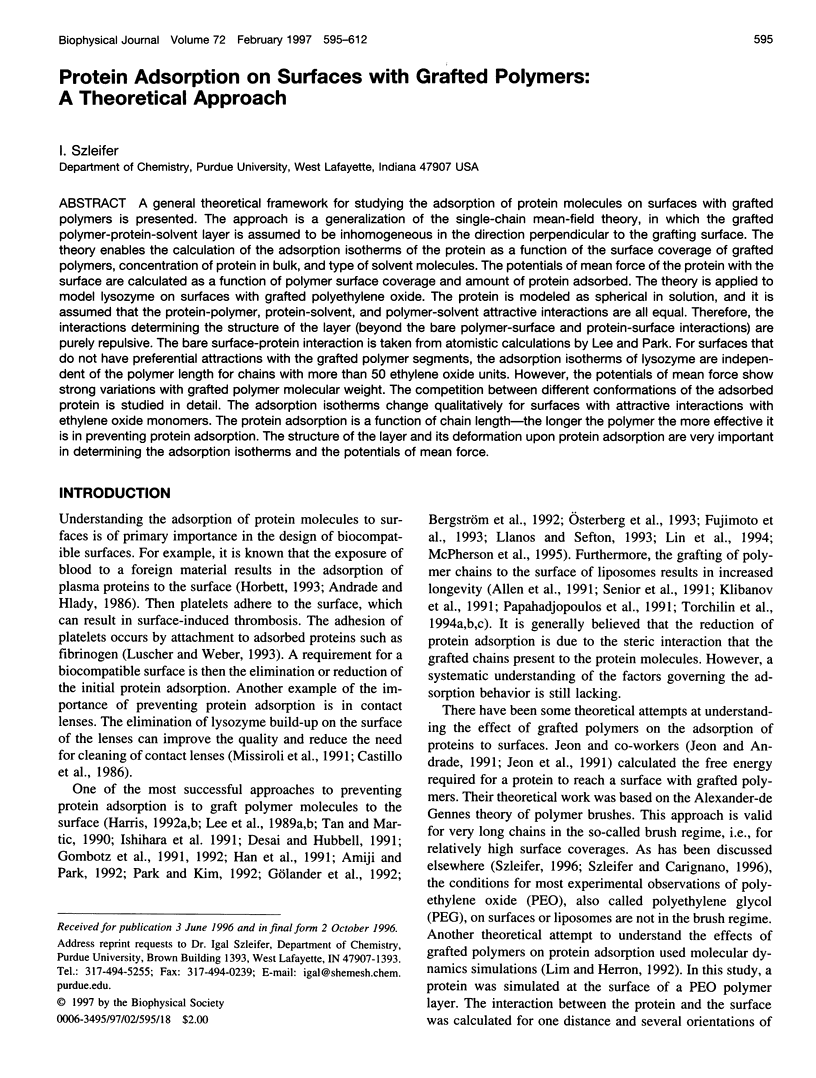
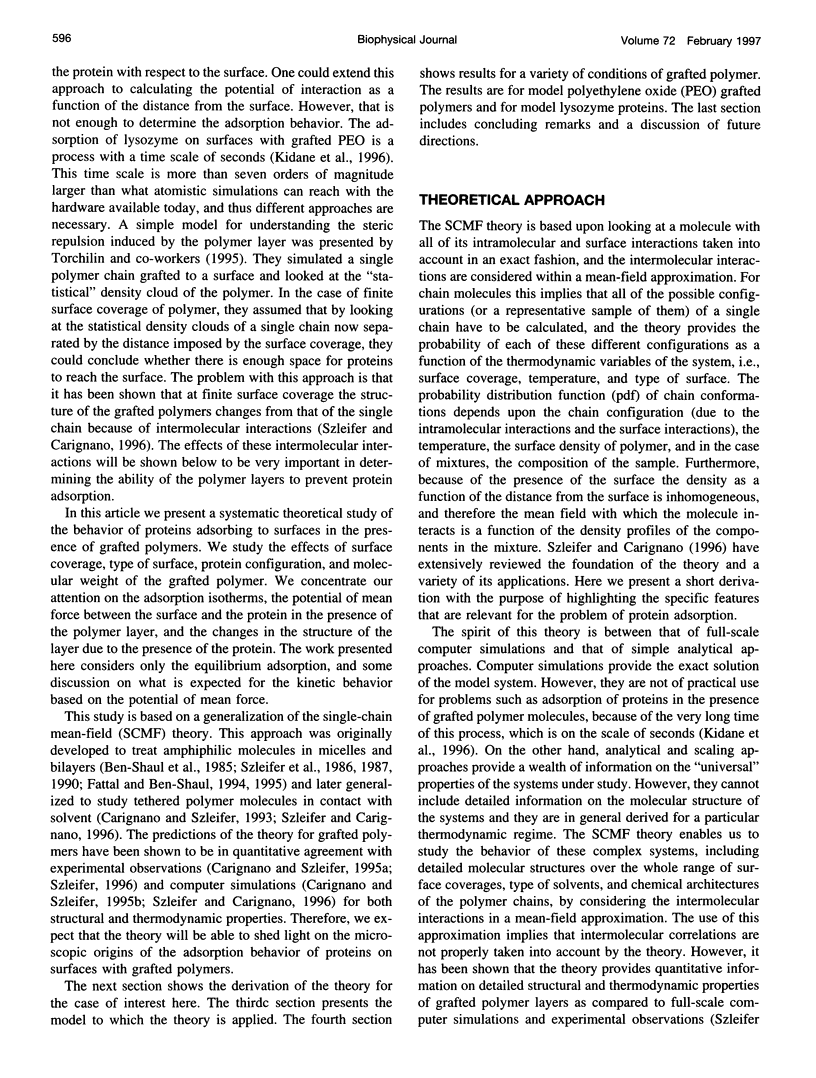

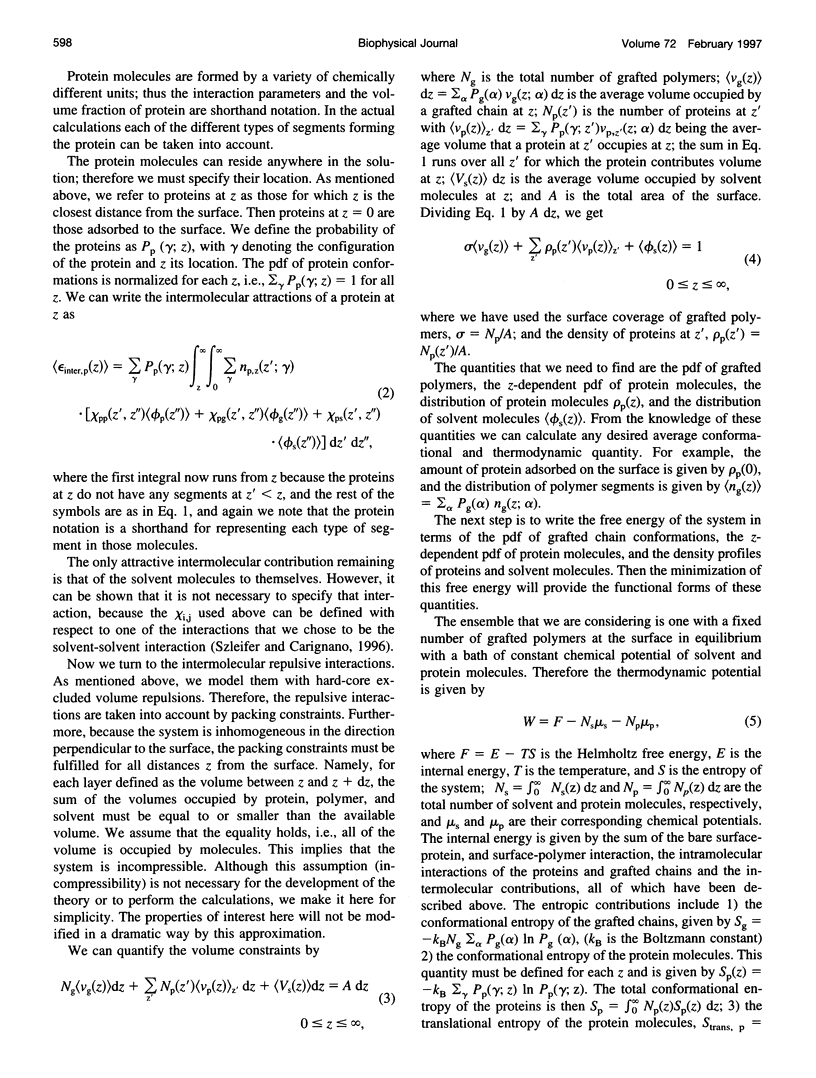
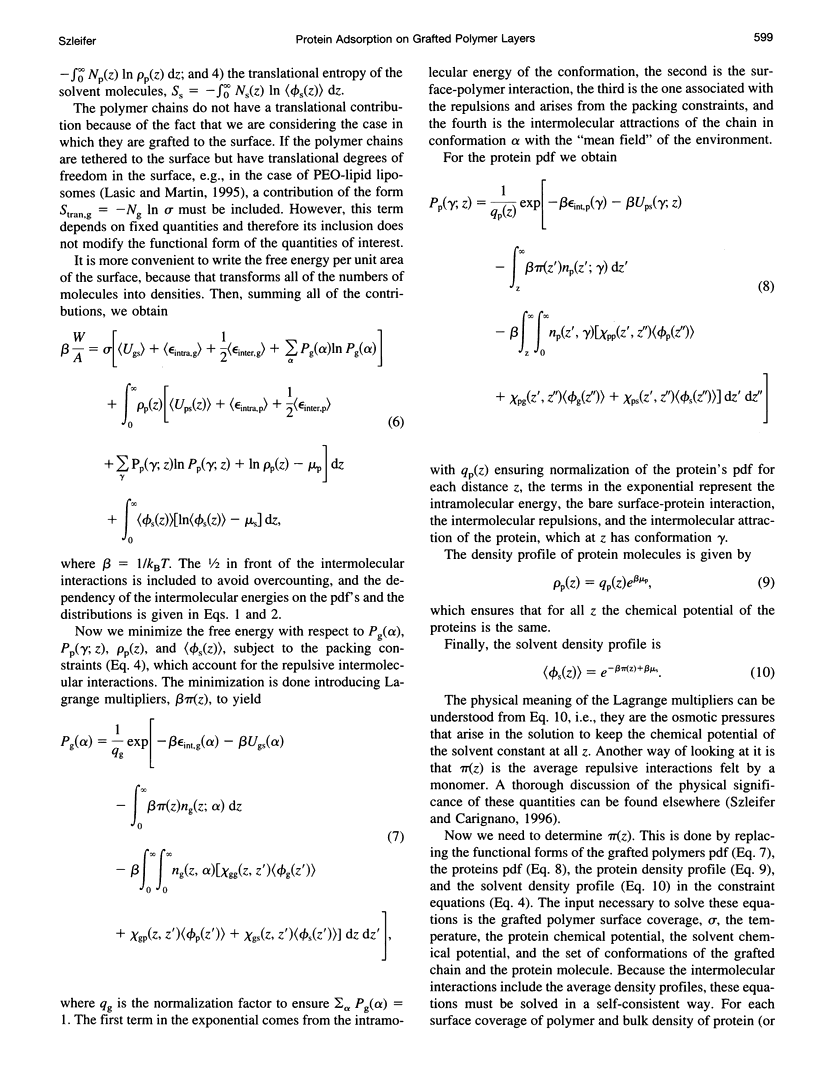
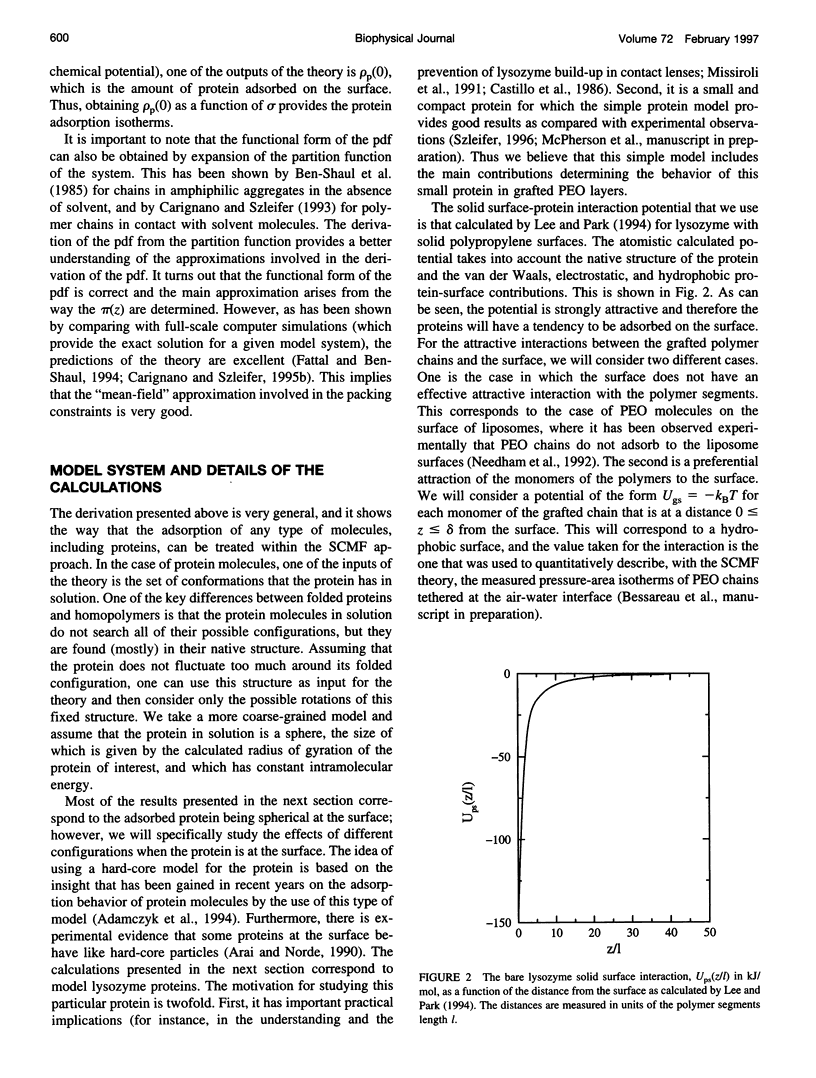
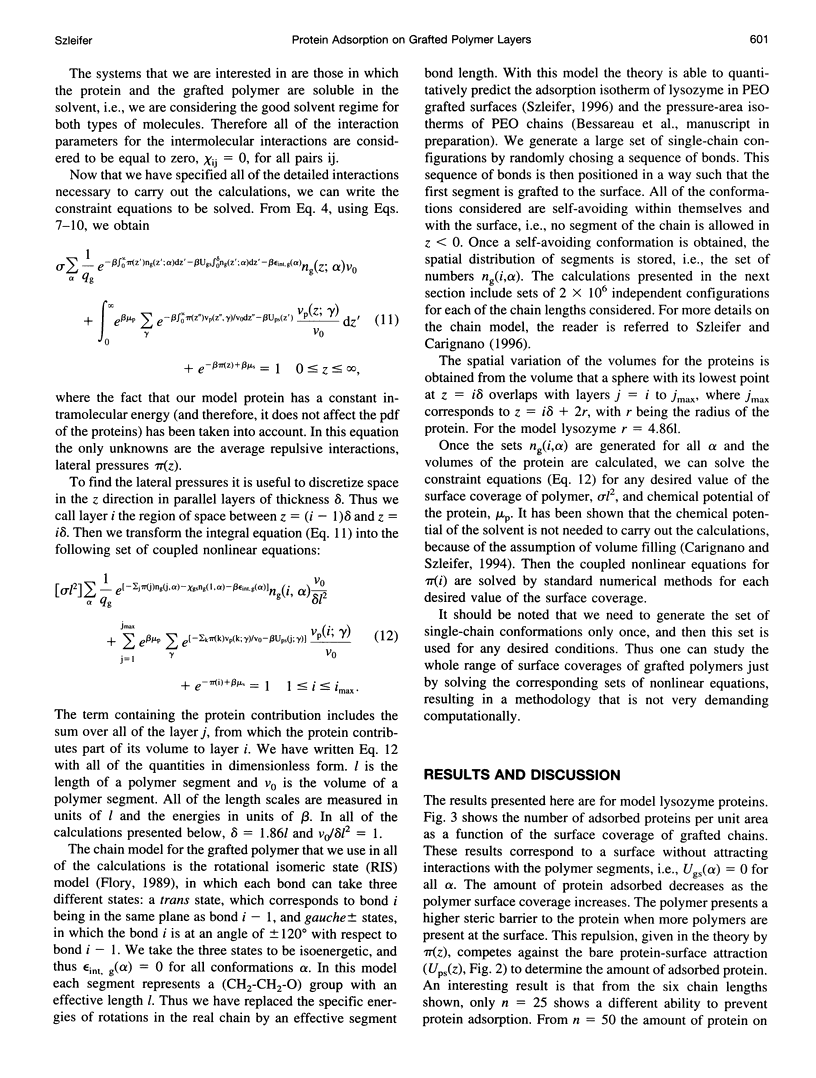

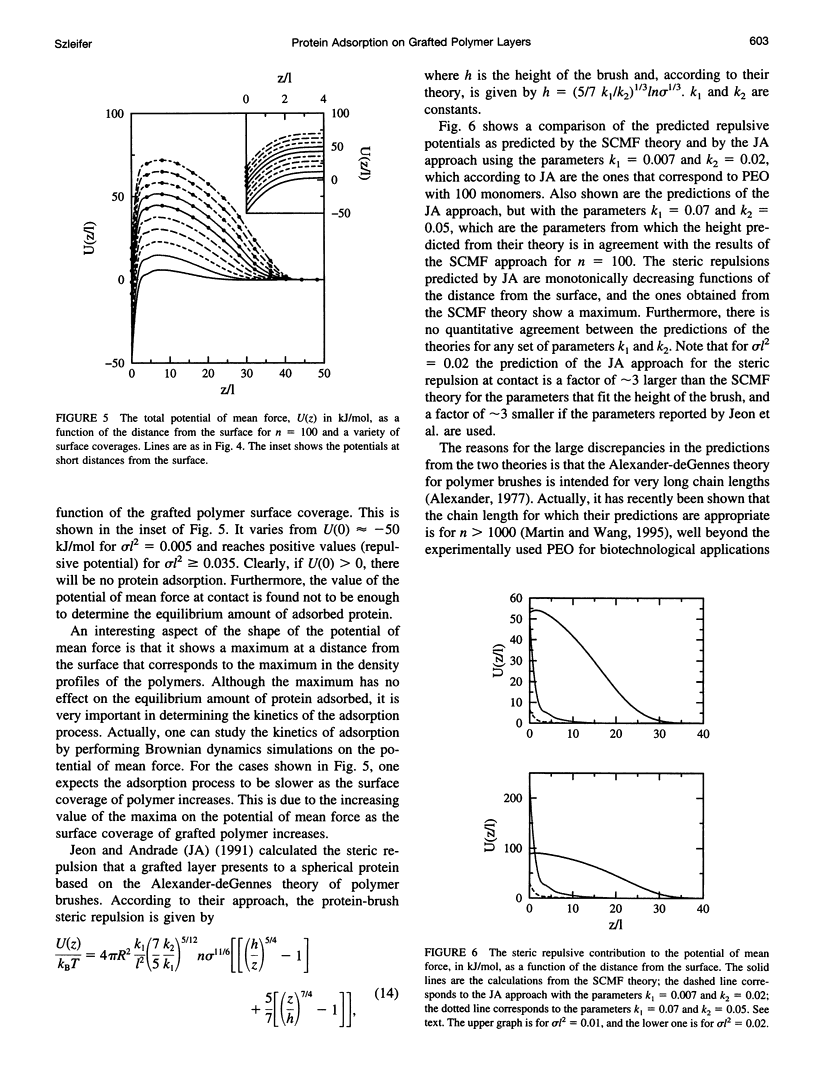
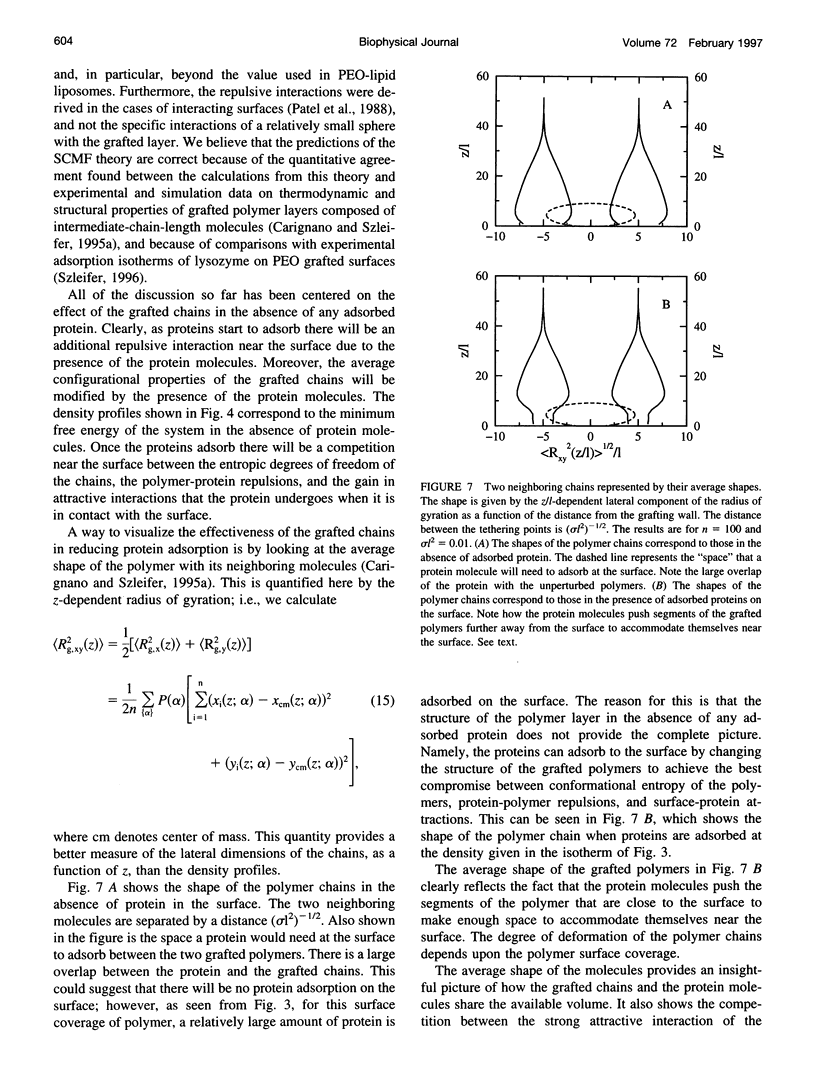
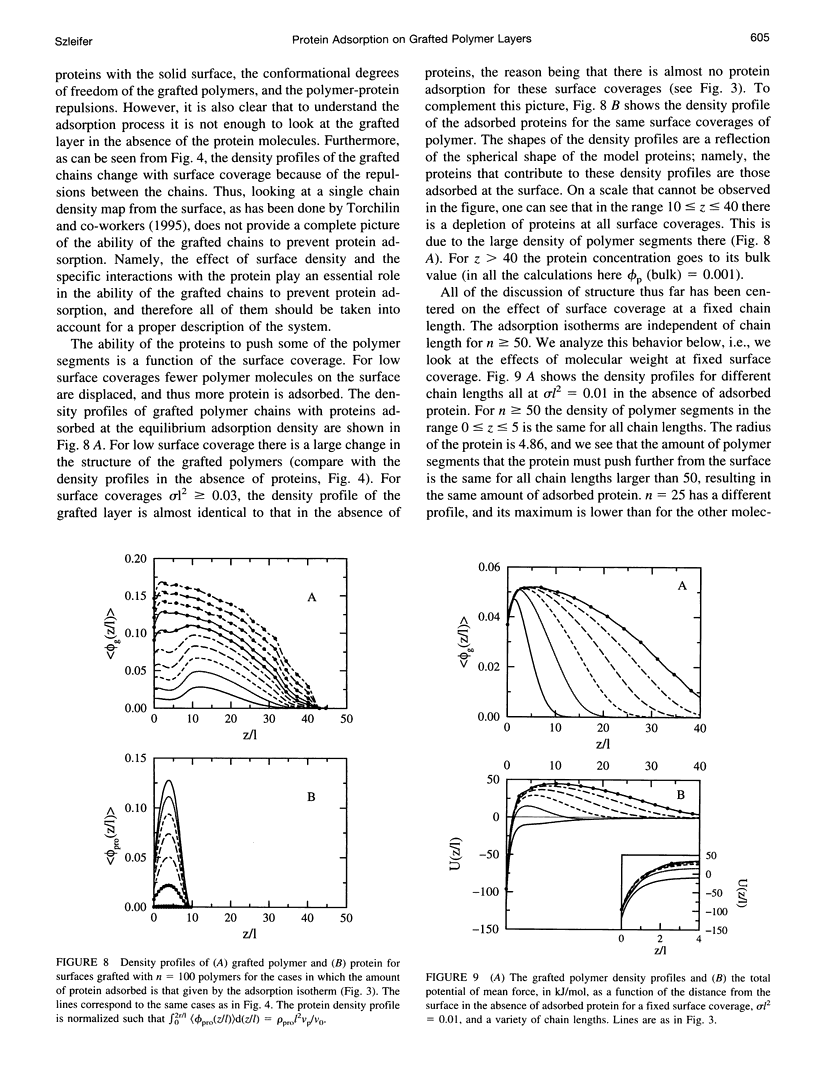
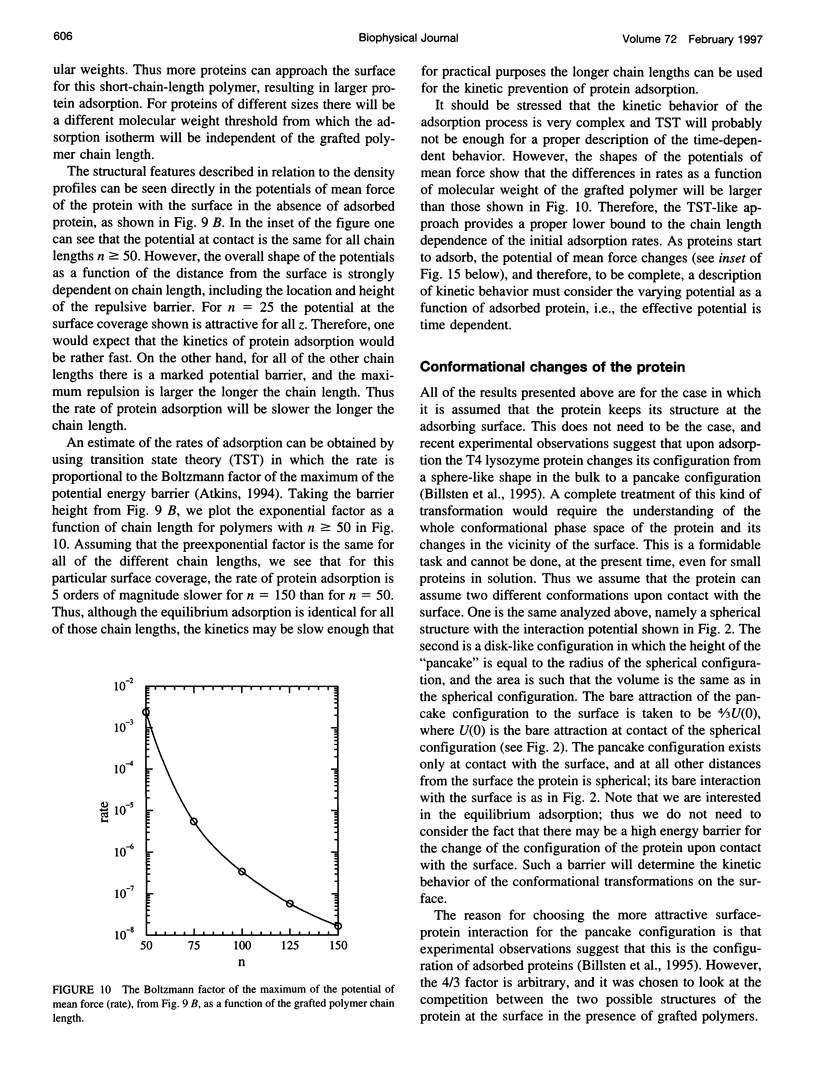
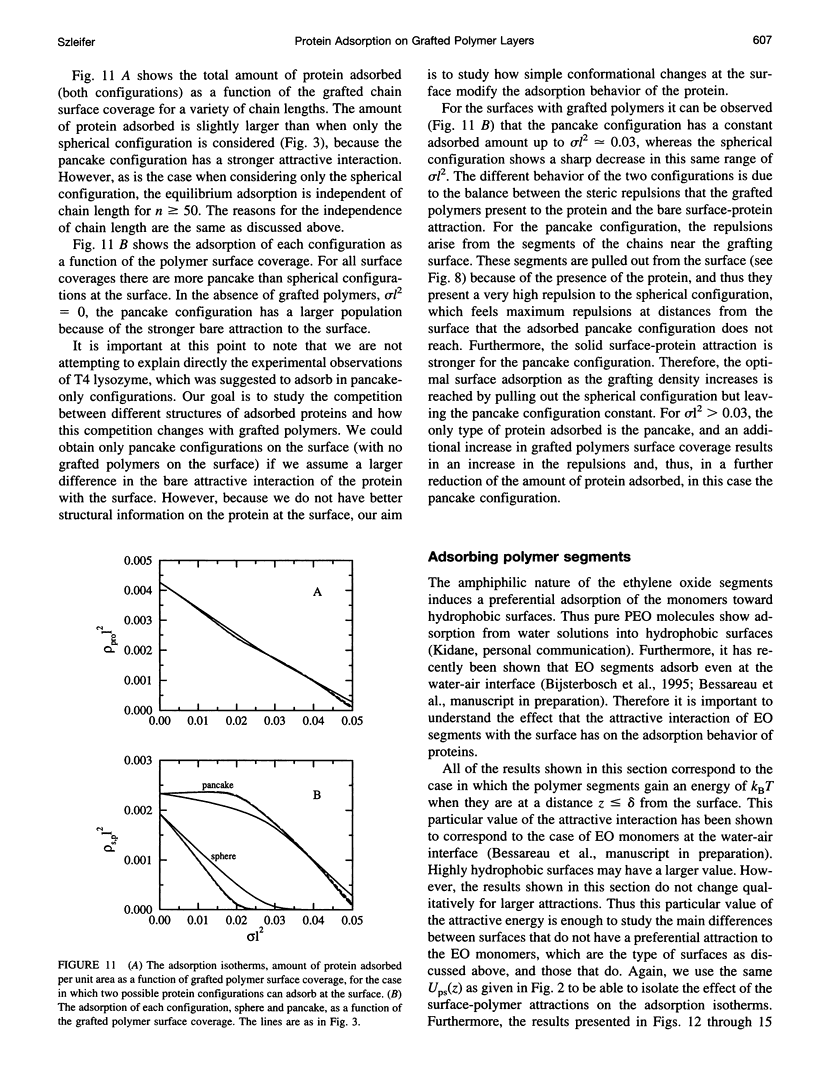
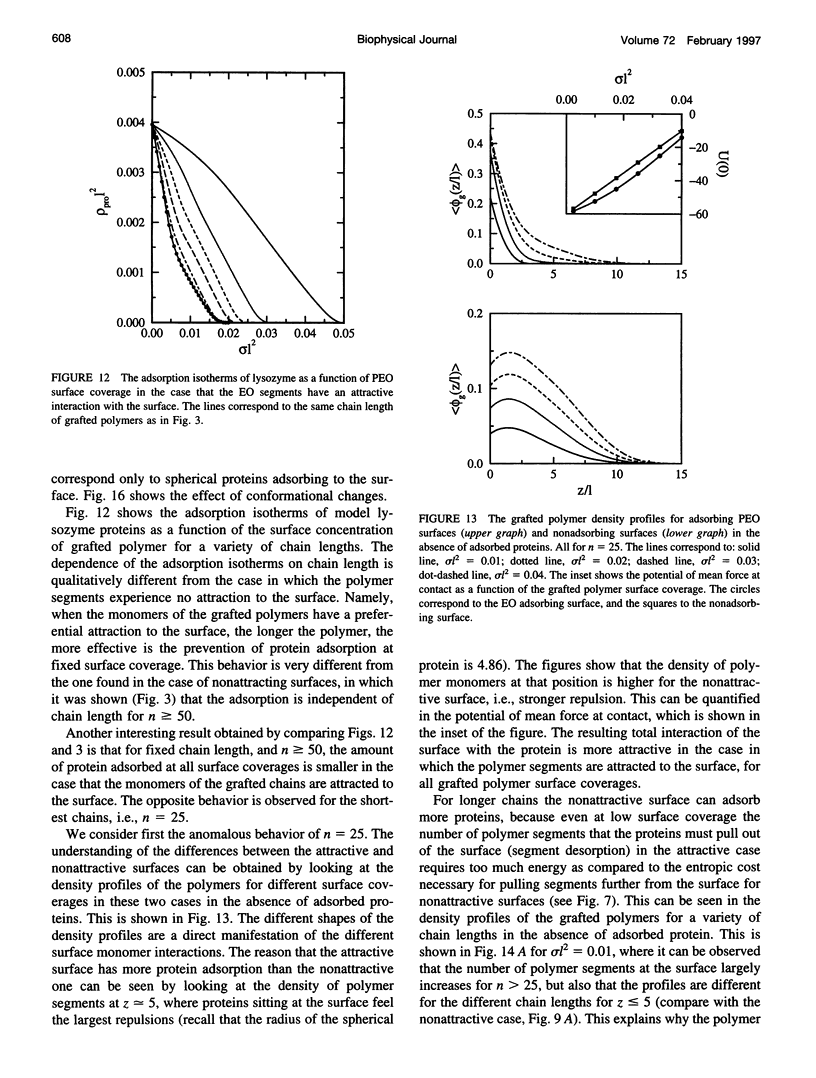
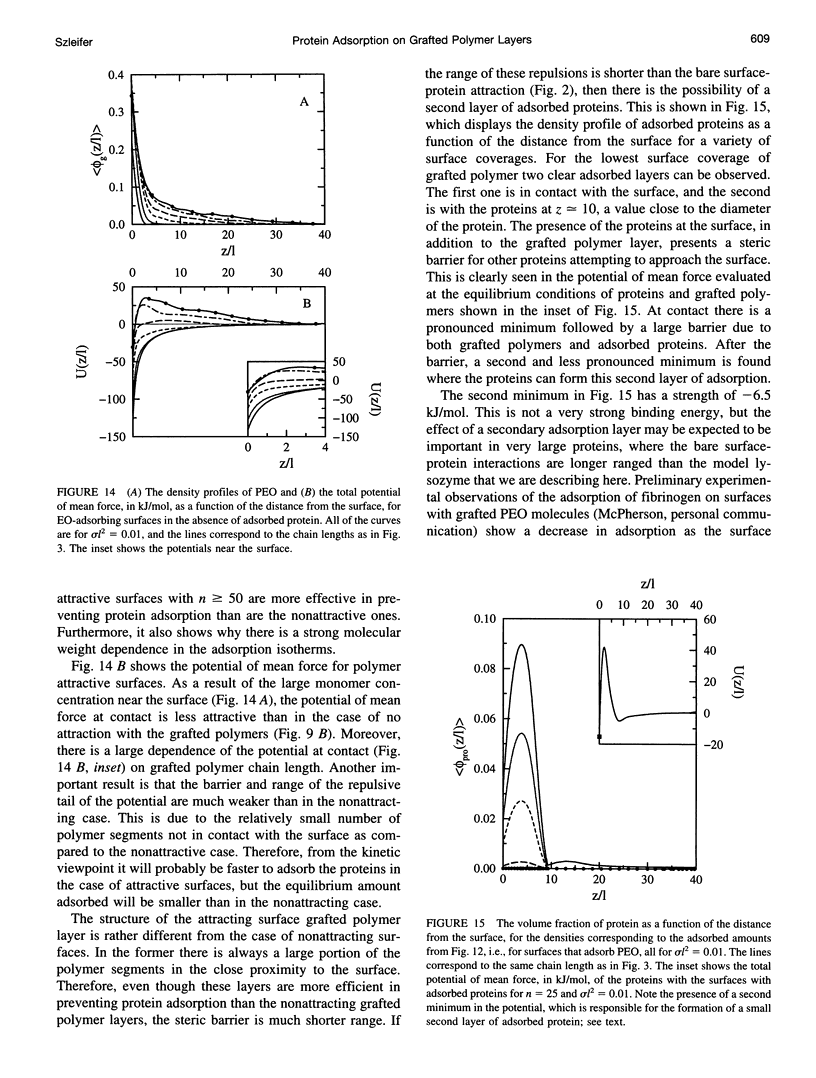
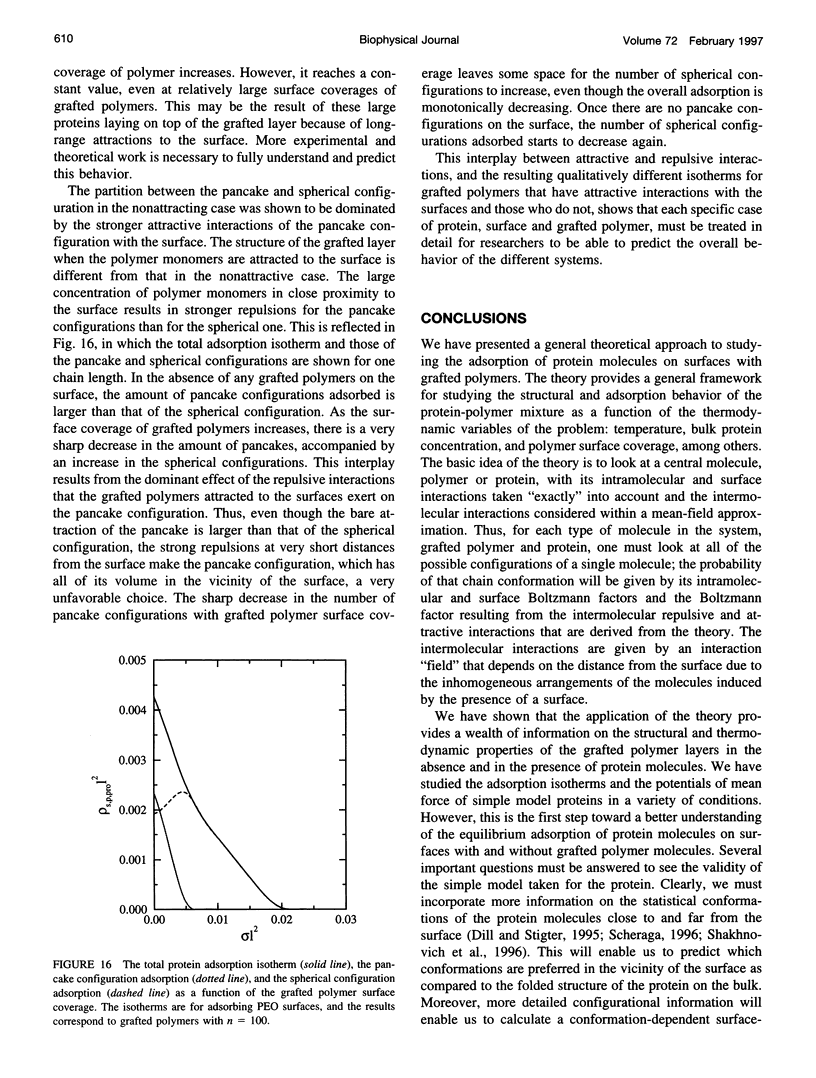
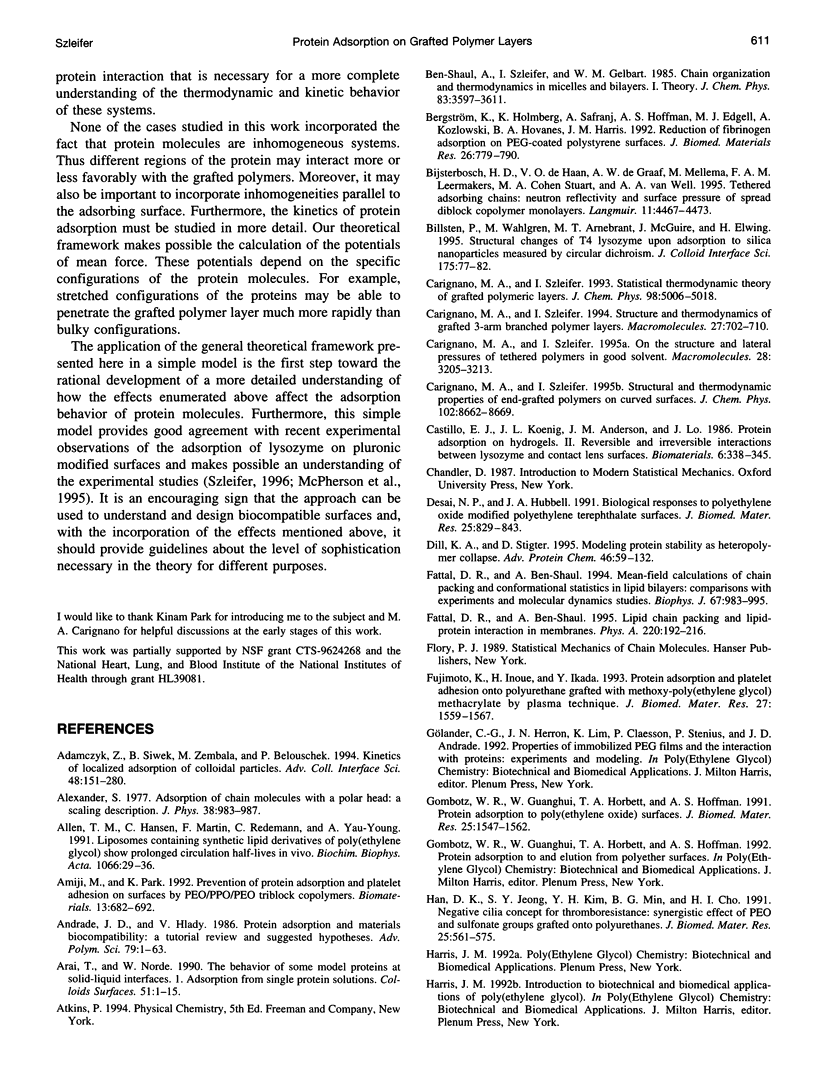
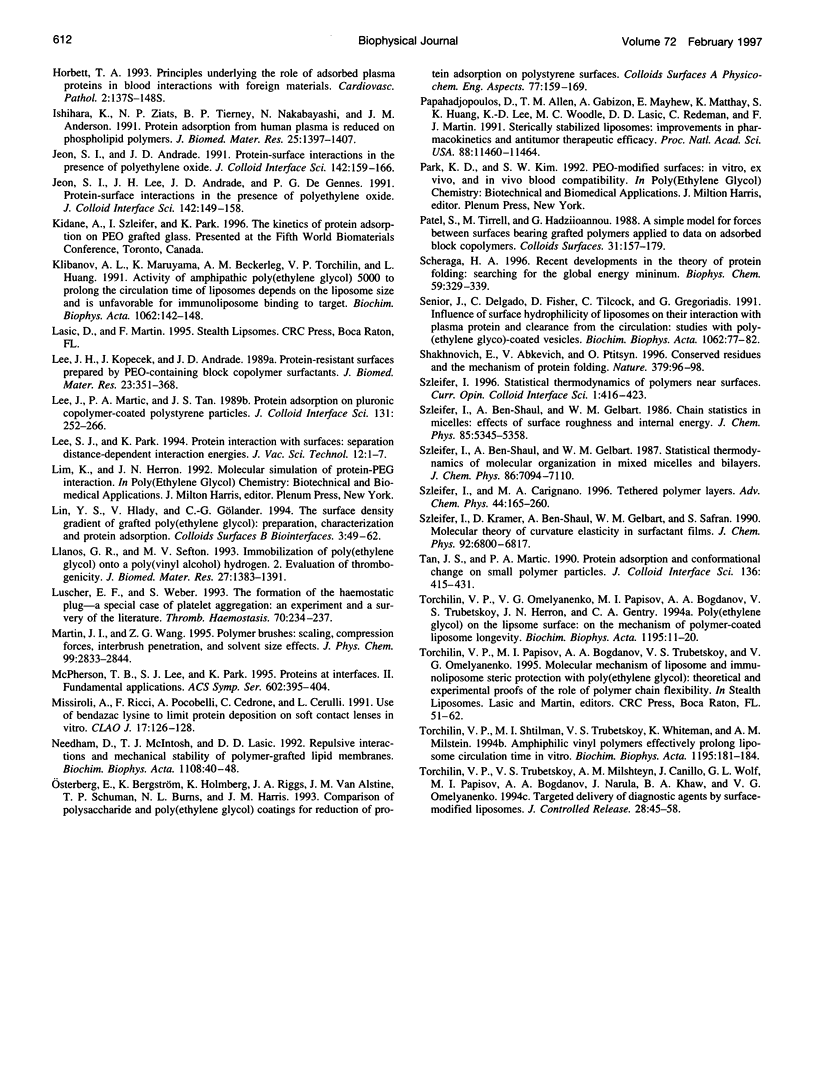
Selected References
These references are in PubMed. This may not be the complete list of references from this article.
- Allen T. M., Hansen C., Martin F., Redemann C., Yau-Young A. Liposomes containing synthetic lipid derivatives of poly(ethylene glycol) show prolonged circulation half-lives in vivo. Biochim Biophys Acta. 1991 Jul 1;1066(1):29–36. doi: 10.1016/0005-2736(91)90246-5. [DOI] [PubMed] [Google Scholar]
- Amiji M., Park K. Prevention of protein adsorption and platelet adhesion on surfaces by PEO/PPO/PEO triblock copolymers. Biomaterials. 1992;13(10):682–692. doi: 10.1016/0142-9612(92)90128-b. [DOI] [PubMed] [Google Scholar]
- Bergström K., Holmberg K., Safranj A., Hoffman A. S., Edgell M. J., Kozlowski A., Hovanes B. A., Harris J. M. Reduction of fibrinogen adsorption on PEG-coated polystyrene surfaces. J Biomed Mater Res. 1992 Jun;26(6):779–790. doi: 10.1002/jbm.820260607. [DOI] [PubMed] [Google Scholar]
- Castillo E. J., Koenig J. L., Anderson J. M., Lo J. Protein adsorption on hydrogels. II. Reversible and irreversible interactions between lysozyme and soft contact lens surfaces. Biomaterials. 1985 Sep;6(5):338–345. doi: 10.1016/0142-9612(85)90089-4. [DOI] [PubMed] [Google Scholar]
- Desai N. P., Hubbell J. A. Biological responses to polyethylene oxide modified polyethylene terephthalate surfaces. J Biomed Mater Res. 1991 Jul;25(7):829–843. doi: 10.1002/jbm.820250704. [DOI] [PubMed] [Google Scholar]
- Dill K. A., Stigter D. Modeling protein stability as heteropolymer collapse. Adv Protein Chem. 1995;46:59–104. doi: 10.1016/s0065-3233(08)60332-0. [DOI] [PubMed] [Google Scholar]
- Fattal D. R., Ben-Shaul A. Mean-field calculations of chain packing and conformational statistics in lipid bilayers: comparison with experiments and molecular dynamics studies. Biophys J. 1994 Sep;67(3):985–995. [PMC free article] [PubMed] [Google Scholar]
- Fujimoto K., Inoue H., Ikada Y. Protein adsorption and platelet adhesion onto polyurethane grafted with methoxy-poly(ethylene glycol) methacrylate by plasma technique. J Biomed Mater Res. 1993 Dec;27(12):1559–1567. doi: 10.1002/jbm.820271213. [DOI] [PubMed] [Google Scholar]
- Gombotz W. R., Wang G. H., Horbett T. A., Hoffman A. S. Protein adsorption to poly(ethylene oxide) surfaces. J Biomed Mater Res. 1991 Dec;25(12):1547–1562. doi: 10.1002/jbm.820251211. [DOI] [PubMed] [Google Scholar]
- Han D. K., Jeong S. Y., Kim Y. H., Min B. G., Cho H. I. Negative cilia concept for thromboresistance: synergistic effect of PEO and sulfonate groups grafted onto polyurethanes. J Biomed Mater Res. 1991 May;25(5):561–575. doi: 10.1002/jbm.820250502. [DOI] [PubMed] [Google Scholar]
- Ishihara K., Ziats N. P., Tierney B. P., Nakabayashi N., Anderson J. M. Protein adsorption from human plasma is reduced on phospholipid polymers. J Biomed Mater Res. 1991 Nov;25(11):1397–1407. doi: 10.1002/jbm.820251107. [DOI] [PubMed] [Google Scholar]
- Klibanov A. L., Maruyama K., Beckerleg A. M., Torchilin V. P., Huang L. Activity of amphipathic poly(ethylene glycol) 5000 to prolong the circulation time of liposomes depends on the liposome size and is unfavorable for immunoliposome binding to target. Biochim Biophys Acta. 1991 Feb 25;1062(2):142–148. doi: 10.1016/0005-2736(91)90385-l. [DOI] [PubMed] [Google Scholar]
- Lee J. H., Kopecek J., Andrade J. D. Protein-resistant surfaces prepared by PEO-containing block copolymer surfactants. J Biomed Mater Res. 1989 Mar;23(3):351–368. doi: 10.1002/jbm.820230306. [DOI] [PubMed] [Google Scholar]
- Llanos G. R., Sefton M. V. Immobilization of poly(ethylene glycol) onto a poly(vinyl alcohol) hydrogel: 2. Evaluation of thrombogenicity. J Biomed Mater Res. 1993 Nov;27(11):1383–1391. doi: 10.1002/jbm.820271105. [DOI] [PubMed] [Google Scholar]
- Lüscher E. F., Weber S. The formation of the haemostatic plug--a special case of platelet aggregation. An experiment and a survey of the literature. Thromb Haemost. 1993 Aug 2;70(2):234–237. [PubMed] [Google Scholar]
- Missiroli A., Ricci F., Pocobelli A., Cedrone C., Cerulli L. Use of bendazac lysine to limit protein deposition on soft contact lenses in vitro. CLAO J. 1991 Apr;17(2):126–128. [PubMed] [Google Scholar]
- Needham D., McIntosh T. J., Lasic D. D. Repulsive interactions and mechanical stability of polymer-grafted lipid membranes. Biochim Biophys Acta. 1992 Jul 8;1108(1):40–48. doi: 10.1016/0005-2736(92)90112-y. [DOI] [PubMed] [Google Scholar]
- Papahadjopoulos D., Allen T. M., Gabizon A., Mayhew E., Matthay K., Huang S. K., Lee K. D., Woodle M. C., Lasic D. D., Redemann C. Sterically stabilized liposomes: improvements in pharmacokinetics and antitumor therapeutic efficacy. Proc Natl Acad Sci U S A. 1991 Dec 15;88(24):11460–11464. doi: 10.1073/pnas.88.24.11460. [DOI] [PMC free article] [PubMed] [Google Scholar]
- Scheraga H. A. Recent developments in the theory of protein folding: searching for the global energy minimum. Biophys Chem. 1996 Apr 16;59(3):329–339. doi: 10.1016/0301-4622(95)00126-3. [DOI] [PubMed] [Google Scholar]
- Senior J., Delgado C., Fisher D., Tilcock C., Gregoriadis G. Influence of surface hydrophilicity of liposomes on their interaction with plasma protein and clearance from the circulation: studies with poly(ethylene glycol)-coated vesicles. Biochim Biophys Acta. 1991 Feb 11;1062(1):77–82. doi: 10.1016/0005-2736(91)90337-8. [DOI] [PubMed] [Google Scholar]
- Shakhnovich E., Abkevich V., Ptitsyn O. Conserved residues and the mechanism of protein folding. Nature. 1996 Jan 4;379(6560):96–98. doi: 10.1038/379096a0. [DOI] [PubMed] [Google Scholar]
- Torchilin V. P., Omelyanenko V. G., Papisov M. I., Bogdanov A. A., Jr, Trubetskoy V. S., Herron J. N., Gentry C. A. Poly(ethylene glycol) on the liposome surface: on the mechanism of polymer-coated liposome longevity. Biochim Biophys Acta. 1994 Oct 12;1195(1):11–20. doi: 10.1016/0005-2736(94)90003-5. [DOI] [PubMed] [Google Scholar]
- Torchilin V. P., Shtilman M. I., Trubetskoy V. S., Whiteman K., Milstein A. M. Amphiphilic vinyl polymers effectively prolong liposome circulation time in vivo. Biochim Biophys Acta. 1994 Oct 12;1195(1):181–184. doi: 10.1016/0005-2736(94)90025-6. [DOI] [PubMed] [Google Scholar]


